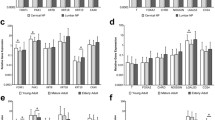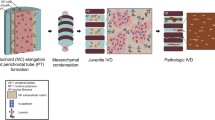Abstract
Differentiation between age (physiological) and disease-induced changes in the nucleus pulposus will facilitate our understanding of the mechanism(s) leading to the development of degenerative disc disease. The aim of this study was to develop an in vitro model that would allow the study of age-induced alterations of cell function in nucleus pulposus. Nucleus pulposus (NP) cells were isolated from intervertebral discs obtained from either calves (<9 months) or cows (>18 months). The cells were placed in culture and grown for 19 days. Although nucleus pulposus tissue was formed by the cells of the two different ages the more mature (older) cells formed less tissue as determined histologically by light microscopy. This was confirmed biochemically as the wet weight and proteoglycan content of the tissue formed by the older cells were significantly less than that of the younger tissue. The older cells accumulated less proteoglycans as determined by quantifying radioisotope incorporation. The older cells showed lower constitutive gene expression of collagen type II and aggrecan whereas collagen type I and link protein levels were similar to those of the younger cells. Metalloprotease (MMP) 13 gene and protein expression increased with age. There was no change in the levels of gene expression of MMP 2 and TIMP 1, 2, or 3 with age. Cells obtained from NP tissue harvested from younger or mature animals showed both genotypic and phenotypic differences in vitro that resulted in the inability of the older cells to reconstitute their extracellular matrix to the same extent as the younger cells. This suggests that this in vitro NP tissue model will be suitable to determine the mechanism(s) regulating age-induced changes.





Similar content being viewed by others
References
Antoniou J, Steffen T, Nelson F, Winterbottom N, Hollander AP, Poole RA, et al (1996) The human lumbar intervertebral disc: evidence for changes in the biosynthesis and denaturation of the extracellular matrix with growth, maturation, ageing, and degeneration. J Clin Invest 98(4):996–1003
Bolton MC, Dudhia J, Bayliss MT (1996) Quantification of aggrecan and link-protein mRNA in human articular cartilage of different ages by competitive reverse transcriptase-PCR. Biochem J 319(Pt 2):489–498
Chelberg MK, Banks GM, Geiger DF, Oegema TR Jr (1995) Identification of heterogeneous cell populations in normal human intervertebral disc. J Anat 186(Pt 1):43–53
Chiba K, Andersson GB, Masuda K, Momohara S, Williams JM, Thonar EJ (1998) A new culture system to study the metabolism of the intervertebral disc in vitro. Spine 23(17):1821–1867
Feng H, Danfelter M, Stromqvist B, Heinegard D (2006) Extracellular matrix in disc degeneration. J Bone Joint Surg Am 88(Suppl 2):25–29
Goodman SA, May SA, Heinegard D, Smith RK (2004) Tenocyte response to cyclical strain and transforming growth factor beta is dependent upon age and site of origin. Biorheology 41(5):613–628
Grunhagen T, Wilde G, Soukane DM, Shirazi-Adl SA, Urban JP (2006) Nutrient supply and intervertebral disc metabolism. J Bone Joint Surg Am 88(Suppl 2):30–35
Haas TL, Stitelman D, Davis SJ, Apte SS, Madri JA (1999) Egr-1 mediates extracellular matrix-driven transcription of membrane type 1 matrix metalloproteinase in endothelium. J Biol Chem 274(32):22679–22685
Johnson WE, Evans H, Menage J, Eisenstein SM, El HA, Roberts S (2001) Immunohistochemical detection of Schwann cells in innervated and vascularized human intervertebral discs. Spine 26(23):2550–2557
Le Maitre CL, Freemont AJ, Hoyland JA (2004) Localization of degradative enzymes and their inhibitors in the degenerate human intervertebral disc. J Pathol 204(1):47–54
Le Maitre CL, Hoyland JA, Freemont AJ (2004) Studies of human intervertebral disc cell function in a constrained in vitro tissue culture system. Spine 29(11):1187–1195
Lindsey ML, Goshorn DK, Squires CE, Escobar GP, Hendrick JW, Mingoia JT, et al (2005) Age-dependent changes in myocardial matrix metalloproteinase/tissue inhibitor of metalloproteinase profiles and fibroblast function. Cardiovasc Res 66(2):410–419
Lotz JC, Ulrich JA (2006) Innervation, inflammation, and hypermobility may characterize pathologic disc degeneration: review of animal model data. J Bone Joint Surg Am 88(Suppl 2):76–82
Maeda S, Kokubun S (2000) Changes with age in proteoglycan synthesis in cells cultured in vitro from the inner and outer rabbit annulus fibrosus. Responses to interleukin-1 and interleukin-1 receptor antagonist protein. Spine 25(2):166–169
Martin JA, Buckwalter JA (2002) Aging, articular cartilage chondrocyte senescence and osteoarthritis. Biogerontology 3(5):257–264
McNulty M, Spiers P, McGovern E, Feely J (2005) Aging is associated with increased matrix metalloproteinase-2 activity in the human aorta. Am J Hypertens 18(4 Pt 1):504–509
Murakami H, Yoon ST, ttallah-Wasif ES, Tsai KJ, Fei Q, Hutton WC (2006) The expression of anabolic cytokines in intervertebral discs in age-related degeneration. Spine 31(16):1770–1774
Niedermuller H, Basota I, Strasser A, Hofecker G (2001) Age dependence of signal transduction and cell signaling as a major factor of intervention into the aging process. Arch Gerontol Geriatr 33(2):151–161
Okuda S, Myoui A, Ariga K, Nakase T, Yonenobu K, Yoshikawa H (2001) Mechanisms of age-related decline in insulin-like growth factor-I dependent proteoglycan synthesis in rat intervertebral disc cells. Spine 26(22):2421–2426
Pilliar RM, Filiaggi MJ, Wells JD, Grynpas MD, Kandel RA (2001) Porous calcium polyphosphate scaffolds for bone substitute applications—in vitro characterization. Biomaterials 22(9):963–972
Pytel P, Wollmann RL, Fessler RG, Krausz TN, Montag AG (2006) Degenerative spine disease: pathologic findings in 985 surgical specimens. Am J Clin Pathol 125(2):193–202
Roberts S, Caterson B, Menage J, Evans EH, Jaffray DC, Eisenstein SM (2000) Matrix metalloproteinases and aggrecanase: their role in disorders of the human intervertebral disc. Spine 25(23):3005–3013
Roughley PJ, Alini M, Antoniou J (2002) The role of proteoglycans in aging, degeneration and repair of the intervertebral disc. Biochem Soc Trans 30(Pt 6):869–874
Scharstuhl A, van Beuningen HM, Vitters EL, van der Kraan PM, van den Berg WB (2002) Loss of transforming growth factor counteraction on interleukin 1 mediated effects in cartilage of old mice. Ann Rheum Dis 61(12):1095–1098
Seguin CA, Grynpas MD, Pilliar RM, Waldman SD, Kandel RA (2004) Tissue engineered nucleus pulposus tissue formed on a porous calcium polyphosphate substrate. Spine 29(12):1299–1306
Seguin CA, Pilliar RM, Roughley PJ, Kandel RA (2005) Tumor necrosis factor-alpha modulates matrix production and catabolism in nucleus pulposus tissue. Spine 30(17):1940–1948
Sivan S, Merkher Y, Wachtel E, Ehrlich S, Maroudas A (2006) Correlation of swelling pressure and intrafibrillar water in young and aged human intervertebral discs. J Orthop Res 24(6):1292–1298
Sztrolovics R, Alini M, Roughley PJ, Mort JS (1997) Aggrecan degradation in human intervertebral disc and articular cartilage. Biochem J 326(Pt 1):235–241
Sztrolovics R, Alini M, Mort JS, Roughley PJ (1999) Age-related changes in fibromodulin and lumican in human intervertebral discs. Spine 24(17):1765–1771
Tsuji T, Chiba K, Imabayashi H, Fujita Y, Hosogane N, Okada Y, et al (2007) Age-related changes in expression of tissue inhibitor of metalloproteinases-3 associated with transition from the notochordal nucleus pulposus to the fibrocartilaginous nucleus pulposus in rabbit intervertebral disc. Spine 32(8):849–856
Urban JP, Roberts S (2003) Degeneration of the intervertebral disc. Arthritis Res Ther 5(3):120–130
Weiler C, Nerlich AG, Zipperer J, Bachmeier BE, Boos N (2002) 2002 SSE award competition in basic science: expression of major matrix metalloproteinases is associated with intervertebral disc degradation and resorption. Eur Spine J 11(4):308–320
Acknowledgments
CS and DH were supported by fellowships from NSERC. We would like to thank Dr Jason Hong for making the CPP, Jennifer Yip for technical assistance and Marie Maguire for secretarial assistance. We would also like to thank Mr Harry Bojarski and Ryding-Regency Meat Packers, Toronto for the tissues. This work was supported by a grant from The Arthritis Society and CIHR-NSERC Collaborative Health Program.
Author information
Authors and Affiliations
Corresponding author
Rights and permissions
About this article
Cite this article
Kandel, R.A., Hamilton, D., Séguin, C. et al. An in vitro tissue model to study the effect of age on nucleus pulposus cells. Eur Spine J 16, 2166–2173 (2007). https://doi.org/10.1007/s00586-007-0467-y
Received:
Revised:
Accepted:
Published:
Issue Date:
DOI: https://doi.org/10.1007/s00586-007-0467-y




